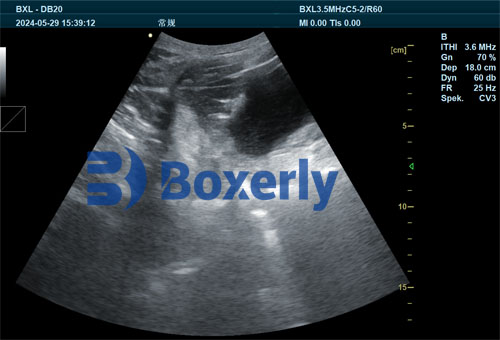In modern swine production, the well-being and productivity of sows during early gestation are critical for successful breeding outcomes. For first-parity sows—those in their first pregnancy—the impact of nutrition on reproductive success is especially profound. Using veterinary ultrasound, farmers and researchers now have a powerful, non-invasive tool to visualize how dietary differences influence uterine development, immune function, and embryo viability in these young breeding animals.
In this article, we explore how ultrasound helps detect the effects of different nutritional levels on first-parity sows during early pregnancy, drawing from international research and best practices in swine production. We also discuss the immunological and genetic implications, and why ultrasound imaging is transforming how producers manage early gestation in pigs.

Understanding the Role of Ultrasound in Swine Reproduction
Ultrasound is a well-established imaging modality in both human and animal medicine. In swine production, its application spans from early pregnancy detection to evaluating uterine health and embryo development. For early-stage pregnancies—especially those in first-parity sows—ultrasound provides real-time visual and quantitative data on fetal structures, fluid accumulation, and uterine condition. This is especially useful for evaluating the effect of nutrition, which is known to influence embryonic survival, hormonal balance, and maternal immunity.
Nutrition and Immune Immunoglobulins in First-Parity Sows
International studies have shown that immune system performance is closely tied to nutritional status during gestation. With the help of ultrasound, researchers have been able to correlate specific serum immunoglobulin levels with the diets of pregnant sows.
At day 12 of pregnancy, sows on medium nutrition levels exhibited significantly higher serum IgG concentrations compared to those on low-nutrition diets (P < 0.01). High-nutrition sows also outperformed low-nutrition counterparts (P < 0.05). These differences became even more pronounced by days 25 and 35, where both high and medium nutrition groups maintained significantly elevated IgG levels.
A similar trend was observed with IgA levels. By day 12, sows on medium and high nutrition regimens had significantly more IgA than those on low-nutrition diets (P < 0.05), with the gap widening by day 35 (P < 0.01). IgM levels followed the same trajectory: medium and high nutrition groups displayed significantly elevated concentrations by days 12 and 25 (P < 0.05), and by day 35, the difference was highly significant (P < 0.01).
From a veterinary perspective, these immunoglobulin trends are crucial. As the immune system plays a pivotal role in embryo survival and maternal health, nutritional interventions based on ultrasound monitoring can significantly improve reproductive outcomes.

Gene Expression in the Uterus and Embryo: A Nutritional Impact
Ultrasound technology not only provides insight into fetal development, but it also enables indirect assessment of gene expression in uterine and embryonic tissues by guiding sample collection and structural interpretation.
First-parity sows on medium-nutrition diets demonstrated higher expression of several immune-related genes, including IFN-α, IFN-β, IFN-γ, Mx1, TLR4, and IL-10, compared to sows on low-nutrition diets (P < 0.05). These genes are crucial in maternal-fetal signaling, antiviral defense, and inflammation control. Notably, TNF-α expression was significantly higher in the low-nutrition group (P < 0.05), a gene associated with inflammatory stress and possible pregnancy complications.
The use of ultrasound imaging helped identify uterine regions with signs of stress or underdevelopment, enabling targeted sampling and more accurate molecular analysis. This integration of imaging and genomics is a growing trend in veterinary science, enhancing precision and decision-making in reproductive management.
Embryo Survival Rate: Ultrasound Monitoring Across Gestation
Ultrasound plays a critical role in estimating embryo survival rates. In a comparative analysis:
At 12 days, medium-nutrition sows had significantly higher embryo survival rates than the high-nutrition group (P < 0.05), while the difference between medium and low groups was not significant.
By days 25 and 35, the medium-nutrition group consistently showed superior embryo survival compared to both high and low-nutrition groups (P < 0.05). Interestingly, the high and low-nutrition groups showed no significant difference.
These results suggest that excessive nutrient intake early in pregnancy may negatively affect embryo survival, perhaps due to metabolic stress or hormonal imbalances. Ultrasound allowed real-time tracking of embryo development, gestational sac integrity, and uterine tone, providing immediate feedback for adjusting feed programs.
Global Understanding of Sow Nutrition and Imaging
In the United States and Europe, the role of precision feeding during early gestation is increasingly emphasized. The goal is not simply to increase feed intake but to balance energy, protein, and micronutrient profiles to optimize immune health and embryo development. Swine production systems in countries like Denmark and the Netherlands now rely heavily on ultrasound-assisted monitoring to fine-tune feeding strategies.
In contrast, some Asian practices have traditionally favored higher energy feed in early pregnancy. However, recent research aligns with Western studies showing that moderate nutrition—not high-energy excess—leads to better reproductive performance in first-parity sows.
This alignment of global findings has led to broader adoption of ultrasound imaging in pig farms worldwide. From commercial farms in Germany to research facilities in Canada and Korea, ultrasound is used not only as a diagnostic tool but also as a strategic asset for reproductive planning.
Best Practices: Ultrasound Scanning Guidelines
On-farm ultrasound scanning typically begins around day 12 post-breeding to detect early gestation markers. The following are standard practices:
Transabdominal scanning: Ideal for day 25+ evaluations of fetus count and uterine structure.
Transrectal ultrasound: Offers earlier and more detailed images around day 12–18, particularly in first-parity sows.
Real-time B-mode imaging: Essential for evaluating embryonic sacs, heartbeat detection, and uterine uniformity.
Many modern ultrasound machines are portable and user-friendly, making it feasible to integrate them into daily swine herd management. Models like the BXL-V50 and BXL-DZ20 are commonly used across pig farms and have become popular for their high image clarity and battery life in field settings.
Implications for Swine Producers
Combining nutritional data with ultrasound findings enables swine producers to:
Improve immune protection for the sow and fetus
Enhance embryo viability
Reduce pregnancy losses
Optimize feed efficiency
Implement precision breeding programs
By focusing on early gestation—a critical but often overlooked period—producers can make a measurable difference in overall reproductive success and herd profitability.
Why This Matters Beyond Swine: Lessons from Aquaculture
Interestingly, insights from other animal sciences support the significance of nutrition-imaging links. In aquaculture, for instance, species like Sebastes schlegelii (black rockfish) have shown altered reproductive outcomes based on early nutritional interventions and immune signaling. Though fish and pigs are different species, the principles of maternal immunity, gene expression, and developmental stability remain similar. It reinforces the importance of real-time imaging and tailored nutrition during reproduction.
Conclusion
Ultrasound imaging has become an indispensable tool in swine reproduction, especially for managing first-parity sows. Through precise assessment of immune function, gene expression, and embryo viability, ultrasound helps swine producers tailor nutritional strategies for optimal outcomes.
As research continues to expand and technology becomes more accessible, the integration of ultrasonography into routine herd management will undoubtedly enhance reproductive efficiency and animal welfare on a global scale.
Reference Sources:
Whitaker, D. A., & Smith, E. (2021). Veterinary Ultrasonography in Food-Producing Animals. Journal of Veterinary Imaging.
Chantalakhana, C. (2023). Precision Feeding in Swine Reproduction. European Pig Genetics Council.
BXL-Vet. (2025). "Portable Veterinary Ultrasound Machine Price." Retrieved from https://www.bxl-vet.com/portable-veterinary-ultrasound-machine-price.html
tags:


